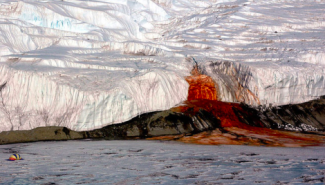
We begin to think of this as an age of gluttony when we realize we’ve stopped tasting the food. Sure there’s a foodie culture that seeks out the best coffee and beer, the best this and the best that — but it’s not the culture in the main. And even “the best” ends up becoming a strange kind of commodity as it becomes mass produced and commonplace. We only taste its “bestness”, not its flavor. In domains where there are economics of abundance, quantity becomes the only measure.

Our senses have been made the target an endless barrage of synthetic stimulation. Even our sleep is turned into “lucid dreaming“, so we can increase the gape of our maw. When we multi-task while we multi-task, only to pause for a moment to multi-task, we lack the distance to perceive how the span of our attention has been doubled and tripled and stretched all the way to the horizon to maximize the programmable surface of our being. Our gluttony is optimized.
The poet Rick Holland attempts to think through the predicament of meditating “on our technological predicament in a crowd of people discussing Facebook.” The classic move when attempting thought while faced with an over-abundance of stimulation was made by John Milton. In his introduction to the second printing of “Paradise Lost” he was asked to explain his choice of unrhymed iambic pentameter — also called “blank verse” or “heroic verse”.
THE Measure is English Heroic Verse without Rime, as that of Homer in Greek, and Virgil in Latin; Rhime being no necessary Adjunct or true Ornament of Poem or good Verse, in longer Works especially, but the Invention of a barbarous Age, to set off wretched matter and lame Meeter; grac’t indeed since by the use of some famous modern Poets, carried away by Custom, but much to thir own vexation, hindrance, and constraint to express many things otherwise, and for the most part worse then else they would have exprest them. Not without cause therefore some both Italian, and Spanish Poets of prime note have rejected Rhime both in longer and shorter Works, as have also long since our best English Tragedies, as a thing of itself, to all judicious ears, triveal, and of no true musical delight; which consists only in apt Numbers, fit quantity of Syllables, and the sense variously drawn out from one Verse into another, not in the jingling sound of like endings, a fault avoyded by the learned Ancients both in Poetry and all good Oratory. This neglect then of Rhime so little is to be taken for a defect, though it may seem so perhaps to vulgar Readers, that it rather is to be esteem’d an example set, the first in English, of ancient liberty recover’d to heroic Poem from the troublesom and modern bondage of Rimeing.
Milton’s desire to throw off the chains of the “modern bondage of Rimeing” was an appeal to the intellect of the reader. The “jingling sound of like endings” would not serve for a poetry that attempted a theodicy — justifying the ways of God to men. This most serious project required “judicious ears”. Poetry not simply read or heard, but heard, read, marked, learned and inwardly digested. Such that a judgement on this theodicy could be rendered.
The philosopher Tim Morton talks about how we’ve come to view poetry as the candy sprinkles stuck to the surface of the scientifically real. Like the rest of the humanities, it’s something that can easily be chucked overboard when it comes time to tighten budgets. Poetry is booked into the balance sheet as a “nice to have” in a bottom-line world. But for Morton “poetry is the blood of causality”, there’s nothing optional about the aesthetic dimension. He thinks that when you do art, you are directly messing with causality.
When one hears the question, “Where does poetry begin?” one is prone to visualize things chugging along in their way, and poetry somehow arising out of the chugging, or being sprinkled along the surface of the chugging like sparks flying out of a complex grinding mechanism. But contemporary physics — going back now to 1900 — tells us that the aesthetic dimension is not some kind of optional fireworks that happen if you’re lucky and happen to have (human) ears, eyes and so on. Poetry is the blood of causality. A fruit fly smells not by inhaling some volatile chemical, but by detecting the quantum signature of a molecule: its shape, which is transmitted nonlocally to receptors in the fly’s olfactory system. Shape, which Aristotle calls morphē, just is what Aristotle thinks as the essence of a thing. This ice cream, right here, this one in my hand — its essence is its form, not an idea in my head or in some transcendental ice cream parlor of the beyond. Somehow we have forgotten how important form is. Form got flushed out of the modern way of thinking about things as pure extension and nothing else — maybe with some accidental candy sprinkles here and there — machinating away in the void.
Rick Holland, among others, is searching for a way for poetry to get a seat at the table. One strategy is to become ultra-serious and austere. With the frivolity of rhyming cast aside, the candy sprinkles are brushed off to reveal the real and serious candy sprinkles underneath, and now the verse is ready for judicious ears. Another method attempts to stop your heart with the beautiful. In the midst of a swirl of sensuality, entice the reader to click the link, to open the door, to go down the rabbit hole. Beauty, so beautiful, it cannot be resisted.
The poet Rachel McKibbens reminds us that the stories we receive aren’t all from search engine results pages or Facebook and Twitter streams. While Morton may think of poetry as a kind of “Realist Magic“, McKibbens says “poetry is a kind of witchcraft“. Both seem to see poetry as a technology for messing with causality.
LM: In her essay, “The Semiotics of Sex,” Jeanette Winterson says, “It is the poet who goes further than any human scientist. The poet who with her dredging net must haul up difficult things and return them to the present.” Do you?
RM: But aren’t the “difficult things” always present? We’ve been taught how to see past the difficult. To bury it. It is why we must constantly name and re-name things, why we spell cast, testify, gift and unbury. Poetry is a kind of witchcraft. We have the power to manifest, to call forth, to make what didn’t happen, happen. I think of the griots who delivered stories from town to town, the soothsayers and playwrights and brujas, all the ceremonies and dedications and incantations and proclamations, everything that starts with the word. And how the word gains its power by being spoken and handed to the next person and how what we write will last longer than our skins, our poems are the truest husks of our former selves.
And so, Rick Holland stands in front of a crowd with a microphone in his hand. The noise of the bar swirls and melds with his voice. Thinking through the idea that metaphor and metonymy may be the original hyperlinks. The musicians take their places, ready to lay down the groove. Old Man Diode is welcomed to the stage. Imagining what life might be like outside of the machine. Bringing back the tradition of the rhapsode… Telling us through the interdigtal blaze that the “linking magic” is our ability to directly mess with causality.
Rick Holland and Old Man Diode
My name is,
as I’m the self consumer of my woes
tonight they self-consume,
to rise and vanish in oblivious host.
TONIGHT I HAVE THE SPIRIT OF THE KING
ROAMING
EXQUISITE THIRSTY, LIVE THROUGH EYES
a creature breathing nothings with the waves
and there is nothing here to take away
no words, no beats, no breaks
except the rising surge and wave
to surge, to die, to surge again,
so please welcome Old Man Diode to the stage
with Wampa, Fya, Plummer, Beth, Onallee, Chris James
yourselves, the wider crowd, and this the linking age
this is the linking magic we all dive deep to save
children of the interdigital age
interdigitally ablaze
these the waves we came to pave as moving floors
and all of us together
KRILL AND KINGS
{Track : Clearing Song}
Squall gone
Shoal left
Moon wrapped
These bits left
These bits
A tech lift horizon
blend free
a Clearing Song
Mapped out there
Where the machines left us
Ran out
Out here
It’s me and you out here




